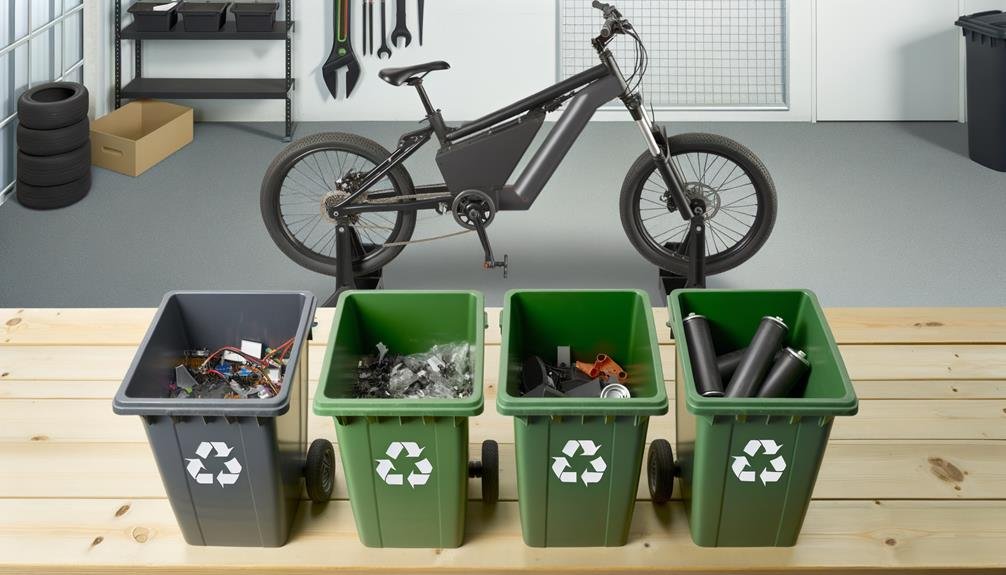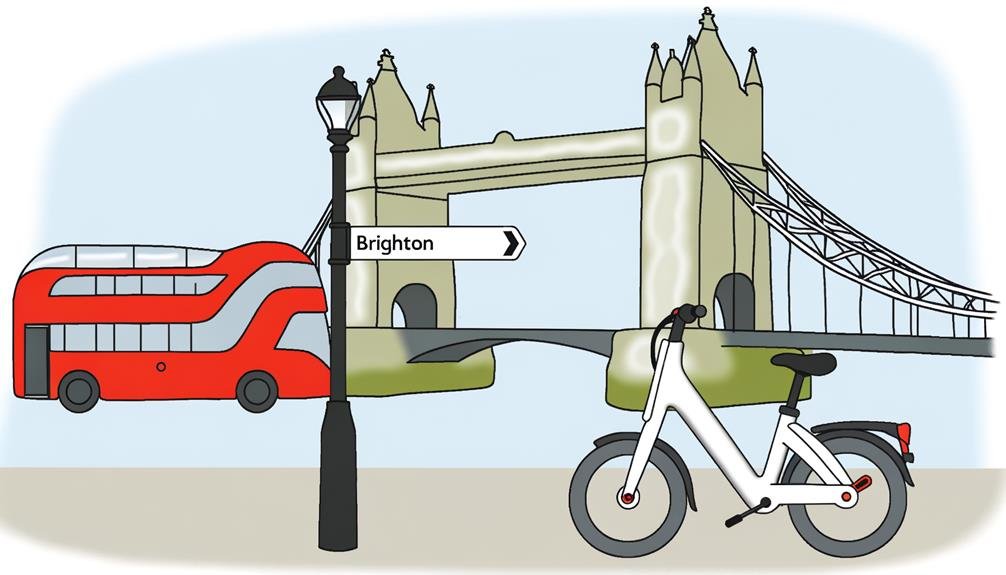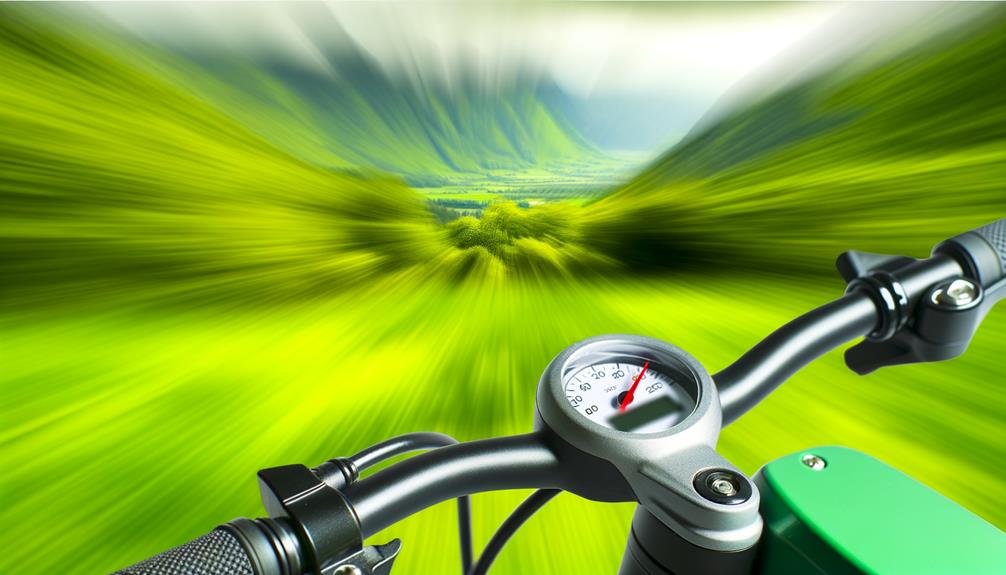Charles Miller is a veteran bike enthusiast with over 12 years of experience dealing with bikes as a mechanic. Despite immense love and expertise for...
If the tortoise from Aesop's fable decided to upgrade to a 250W electric bike, it'd certainly make for a less leisurely race against that overconfident hare!
However, the speed of a 250W eBike is a topic that's a bit more complex than fables and slow-paced reptiles. It's not just about the power of the bike, but a myriad of factors like rider weight, terrain, battery life, and even local laws.
Let's embark on a journey to unravel these factors, and perhaps re-define what we perceive as 'fast'.
Key Takeaways
- The speed of a 250W ebike typically ranges from 15-20 mph, but it can be affected by various factors such as terrain and rider weight.
- Uphill routes and off-road tracks can significantly slow down the speed of an ebike, especially on steep terrains where speeds may be limited to around 8-12 mph.
- Heavier riders generally experience slower speeds, and the relationship between rider weight and ebike speed is crucial for optimizing performance.
- Battery capacity and quality play a significant role in determining the speed and range of a 250W ebike, with high-capacity batteries ensuring consistent speed and longer range.
Understanding 250W Ebike Speed
Let's delve into understanding the speed of a 250W electric bike, which typically reaches 15-20 mph depending on factors such as the terrain and rider's weight. Now, you might be wondering, how fast is a 250W ebike? Well, the answer isn't quite as simple as it seems.
The speed of your ebike is influenced by more than just its wattage. Certain models may have speed restrictions, and it's important to be aware of local regulations regarding ebike speed limits. The motor's speed limit is around 25 km/h, but with a little tweaking, you can increase that limit, with some models reaching 40 km/h.
The number of turns in the motor and the voltage can also affect how fast your ebike goes. Higher voltage can increase the RPM limit, potentially achieving speeds of 45 km/h with a 48V battery. Similarly, wattage and battery capacity impact speed. Cruising at 400 watts achieves 25 km/h, and an 8Ah battery can range about 50 km under ideal conditions.
Impact of Terrain on Speed
Let's now consider how different terrains can affect the speed of a 250W ebike.
Uphill routes can significantly slow your ride, while off-road tracks might present their own unique challenges.
We'll look at these factors and more as we explore the impact of terrain on ebike speed.
Uphill Speed Limitations
When it comes to riding a 250W electric bike, the uphill speed limitations due to steep terrains can significantly reduce your speed, often limiting it to around 8-12 mph. It's important to note that these figures could vary depending on other factors such as the weight of the rider and any additional cargo.
As a member of the ebike community, understanding how terrain impacts performance helps us make informed decisions about routes and expectations. Here's a simple table to illustrate this point:
| Terrain | Speed (mph) |
|---|---|
| Flat | 15-20 |
| Slight incline | 13-15 |
| Moderate incline | 10-12 |
| Steep incline | 8-12 |
Off-Road Performance
Building on the topic of uphill speed limitations, it's equally essential to consider how the off-road performance of a 250W electric bike can be affected by different terrains.
While a 250w ebike typically reaches speeds of 15-20 mph on flat surfaces, this can vary when taking it off-road. Rough terrains, steep inclines, or muddy paths can significantly slow down the bike's speed.
However, don't let this deter you. Embrace the challenge and remember that our biking community thrives on these experiences.
Motor characteristics, wattage, and battery capacity also play a role here.
Remember, safety should always be your priority, so don't rush into unlocking speed limits without considering the potential risks.
We're in this journey together, after all.
Rider Weight and Ebike Speed
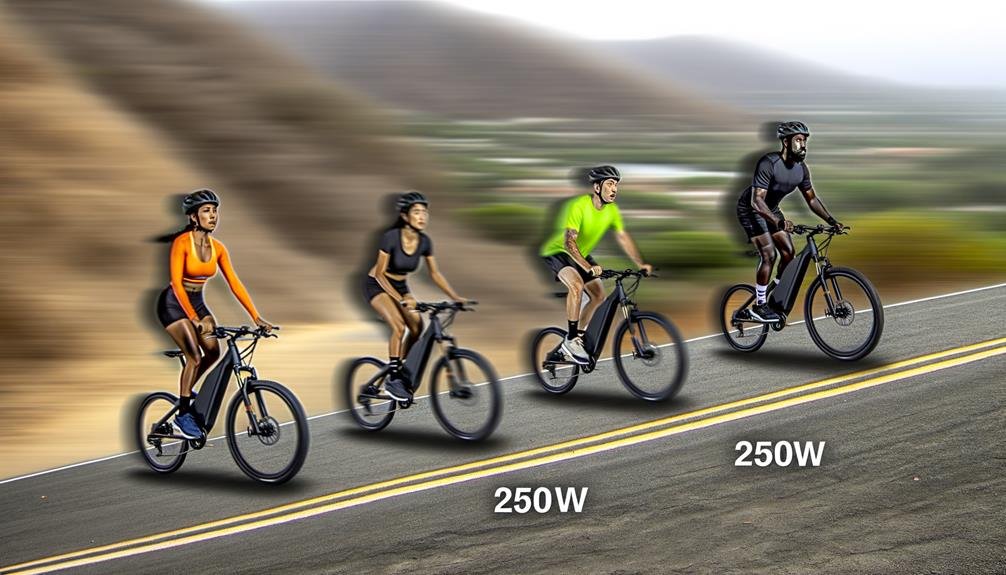
Now let's talk about rider weight and its effect on ebike speed.
It's important to note that the heavier the rider, the slower a 250W ebike will generally be.
We'll look at how to optimize speed despite weight in the following discussion.
Impact of Rider Weight
One crucial factor to consider in understanding the speed of a 250W electric bike is the rider's weight. The impact of rider weight can greatly influence how fast a 250W ebike can go. When we're part of the ebike community, it's important to understand these nuances.
- The heavier the rider, the more power the bike needs to maintain the same speed.
- Lighter riders may find their bikes can go faster with less effort.
Don't forget that terrain can also affect your speed – uphill climbs will be slower!
Always check local regulations regarding ebike speed limits.
Weight Versus Ebike Speed
Understanding the relationship between a rider's weight and the speed of a 250W ebike is crucial for getting the most out of your ride. In the weight versus ebike speed debate, it's clear that a heavier rider may experience slower speeds compared to a lighter one.
To illustrate, here's a simplified table:
| Rider Weight | Estimated Speed of 250W Ebike |
|---|---|
| 70 kg | 20 mph |
| 90 kg | 18 mph |
| 110 kg | 16 mph |
As you can see, the speed of a 250W ebike decreases as the rider's weight increases. This isn't a hard and fast rule, but a general guide. Remember, we're in this journey together, striving to maximize the potential of our 250W ebikes.
Optimizing Speed With Weight
To get the most out of your 250W ebike, it's essential to grasp how your weight affects its overall performance, especially when it comes to speed. Optimizing speed with weight is a key aspect to consider. It's not just about how fast is a 250w ebike, but how fast it can be for you.
Lighter riders may have a slight speed advantage due to reduced resistance.
Rider weight becomes particularly impactful at higher speeds where aerodynamics come into play.
Weight distribution on the ebike and maintaining proper tire pressure can optimize speed.
Your weight can affect ebike speed when climbing hills or against strong winds.
Influence of Battery Power
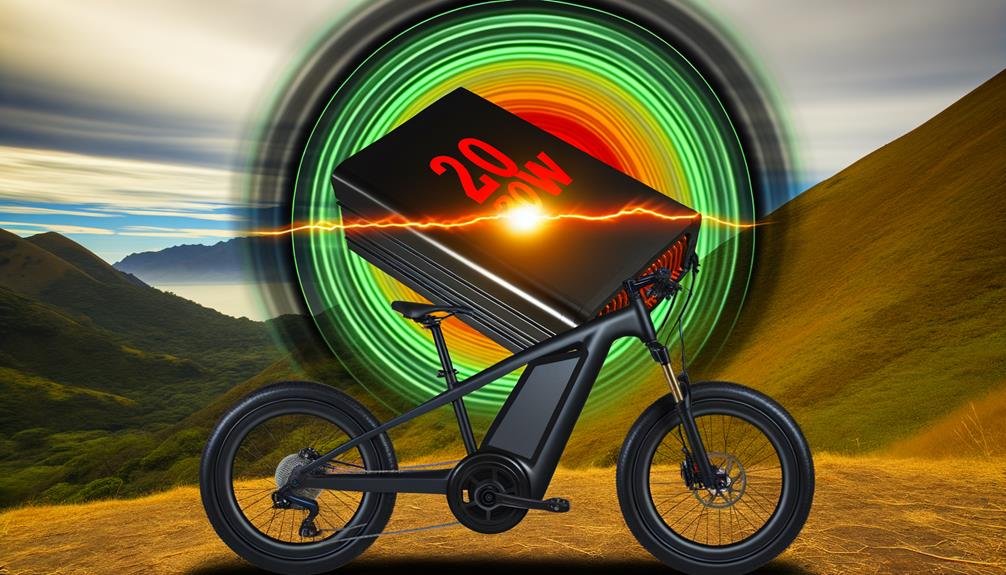
Let's dive into how battery capacity and quality can crank up the wattage output, subsequently influencing the speed and range of a 250W electric bike. As a member of the ebike community, it's essential to understand that the power of your ride lies not just in the motor, but also in the battery.
The influence of battery power on a 250W ebike is significant. A quality battery with a high-capacity can maintain a steady supply of power to the motor, ensuring consistent speed and longer range. On the other hand, a low-quality or low-capacity battery can lead to inconsistent speed and a reduced range.
Motor characteristics, including winding, voltage, and wattage, are critical in determining the top speed of your ebike. However, the battery capacity and quality are the silent influencers that ensure these characteristics are fully optimized.
Speed Limitations of 250W Ebikes
Now that we've uncovered how battery power can boost the performance of a 250W ebike, it's worth exploring the speed limitations of these electric bikes. As part of our ebike community, it's essential to understand these factors to maximize your riding experience while staying within the legal boundaries.
The speed limitations of 250W ebikes are generally dictated by local regulations. For instance:
- In the UK and EU, the limit is usually around 15.5mph
- In the US, the maximum speed is generally 20mph
However, these speeds aren't set in stone. They can be influenced by various elements such as:
- The terrain you're riding on
- Your weight as a rider
- The motor winding and wheel size of the bike
- The voltage and control settings of the bike's controller
Comparing 250W and 500W Ebikes
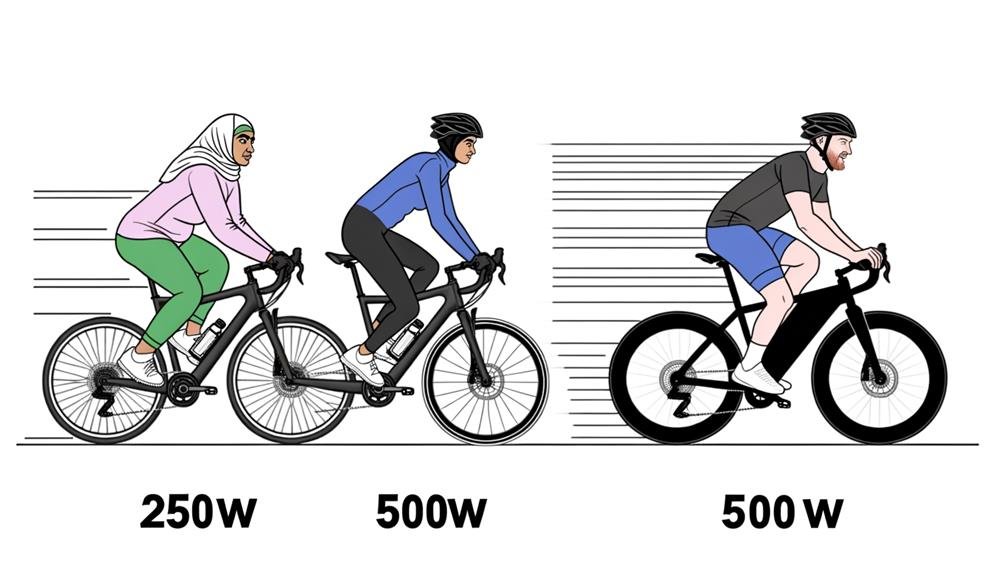
Diving into a comparison between 250W and 500W ebikes, it quickly becomes apparent that both types can reach similar top speeds of around 20 mph, despite the difference in wattage. Although one would assume a 500W ebike to be faster, speed is often limited by wattage. So, regardless of whether you're riding a 250W or 500W ebike, you'll likely hit a top speed of around 20 mph. It's fascinating, isn't it?
Of course, factors such as road conditions, tire size, and your own weight can affect this speed. But generally, the difference in power doesn't translate to a significant difference in speed. Both types are suitable for legal road use in most areas, but be sure to check your local regulations.
In the end, when comparing 250W and 500W ebikes, it's less about speed and more about your personal preferences, needs, and the particular regulations of your area. It's all about finding the right fit for you, and I'm here to help you do just that.
Usage of Gear Systems in 250W Ebikes
While we've established that 250W and 500W ebikes share similar top speeds, it's worth noting that the gear systems in 250W ebikes play a crucial role in optimizing speed and performance across varied terrains. To truly understand how fast a 250W ebike is, we must delve into the usage of gear systems in 250W ebikes.
- The gear systems allow riders to adjust pedal resistance, optimizing speed on various terrains.
- They provide an efficient way of using energy by enabling riders to choose an appropriate gear ratio for different riding conditions.
- Switching between gears allows riders to climb hilly terrains or maintain speed on flat roads without putting excessive strain on the motor.
- The overall riding experience is enhanced with the versatility and adaptability that the gear system provides.
Proper utilization of the gear systems not only improves the ebike's efficiency but can extend the battery life as well. It's this ability to adapt to the rider and the environment that makes the 250W ebike a versatile and efficient mode of transport.
Safety Measures for High Speeds
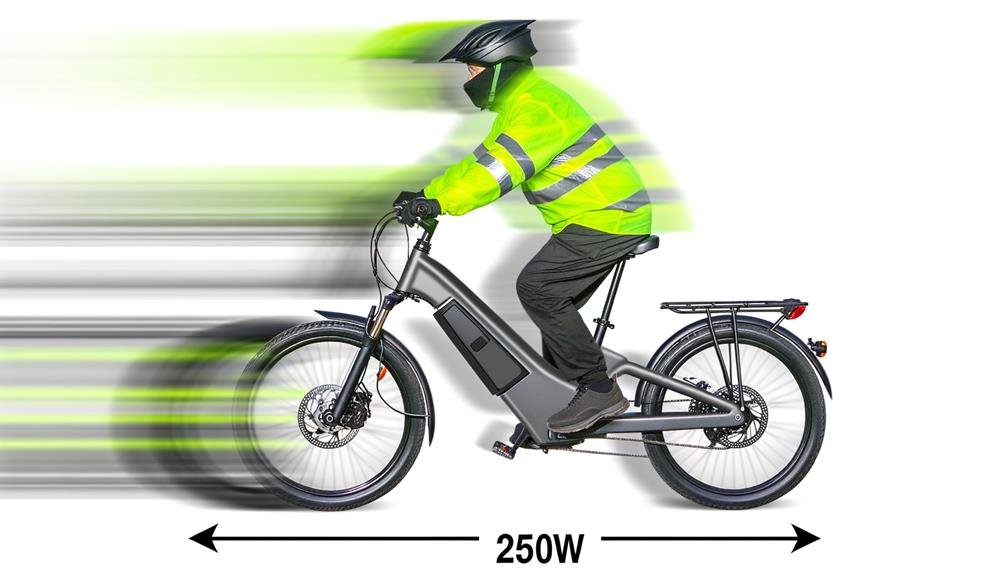
In addition to understanding the speed capabilities of a 250W ebike, it's equally important to consider safety measures when riding at high speeds. When we're zipping along at maximum speed, we must ensure we're doing so safely. Here are some reliable safety measures for high speeds.
| Safety Measures | Importance | Details |
|---|---|---|
| Helmet and Protective Gear | Essential | Protects from severe injuries in case of accidents |
| Brakes Check | Crucial | Ensures effective stopping at high speeds |
| Tire Pressure and Tread Check | Vital | Provides optimal traction and control |
| Traffic Laws and Regulations | Mandatory | Promotes safe and courteous riding |
Always wear a helmet and other protective gear. It's essential for preventing severe injuries if accidents occur. Regularly check your brakes. It's crucial for stopping effectively at high speeds. Keep an eye on your tire pressure and tread. These are vital for maintaining control and traction, especially at maximum speed. Lastly, always follow traffic laws and regulations. They're mandatory for safe and courteous riding.
Frequently Asked Questions
Is 250 Watts Enough for E-Bike?
Yes, 250 watts is enough for an e-bike. It'll get me around town just fine. It might struggle with steep hills though. For a more powerful ride, I'd consider a higher wattage.
How Can I Make My 250w Ebike Faster?
To boost your 250W ebike's speed, you could consider tweaking the controller, changing the wheel size, or boosting the battery capacity. Just remember, it's crucial to adhere to local speed laws and safety guidelines.
What Is the Difference Between a 250w and a 500w Electric Bike?
The main difference between a 250W and a 500W eBike is speed and power. A 500W bike's stronger, faster, and can handle tougher terrains better. But remember, more power often means a shorter battery life.
What Is the Difference Between a 250w and a 350w Electric Bike?
In comparing a 250W to a 350W ebike, the 350W typically offers more power and speed. However, it's also going to drain the battery faster. Your choice really depends on your need for speed versus range.
Conclusion
So, how speedy is a 250W ebike?
Speed is significantly swayed by several factors such as terrain, your own weight, battery power, and bike specifics. Sensibly, it sits at a sturdy 15-20 mph.
Surprisingly, a switch to a 500W ebike only slightly spikes the speed.
Remember, regulations reign over ebike speeds, so stay safe and stick to the stipulated speed limits.
With wise use of gears, you can make the most of these motorized marvels.

Charles Miller is a veteran bike enthusiast with over 12 years of experience dealing with bikes as a mechanic. Despite immense love and expertise for his Tacoma, he rides his Trek Ebike more. Anytime you meet him, you’ll either hear him talking about Bikes, or writing about all things bikes and cars on this blog.
More Posts
